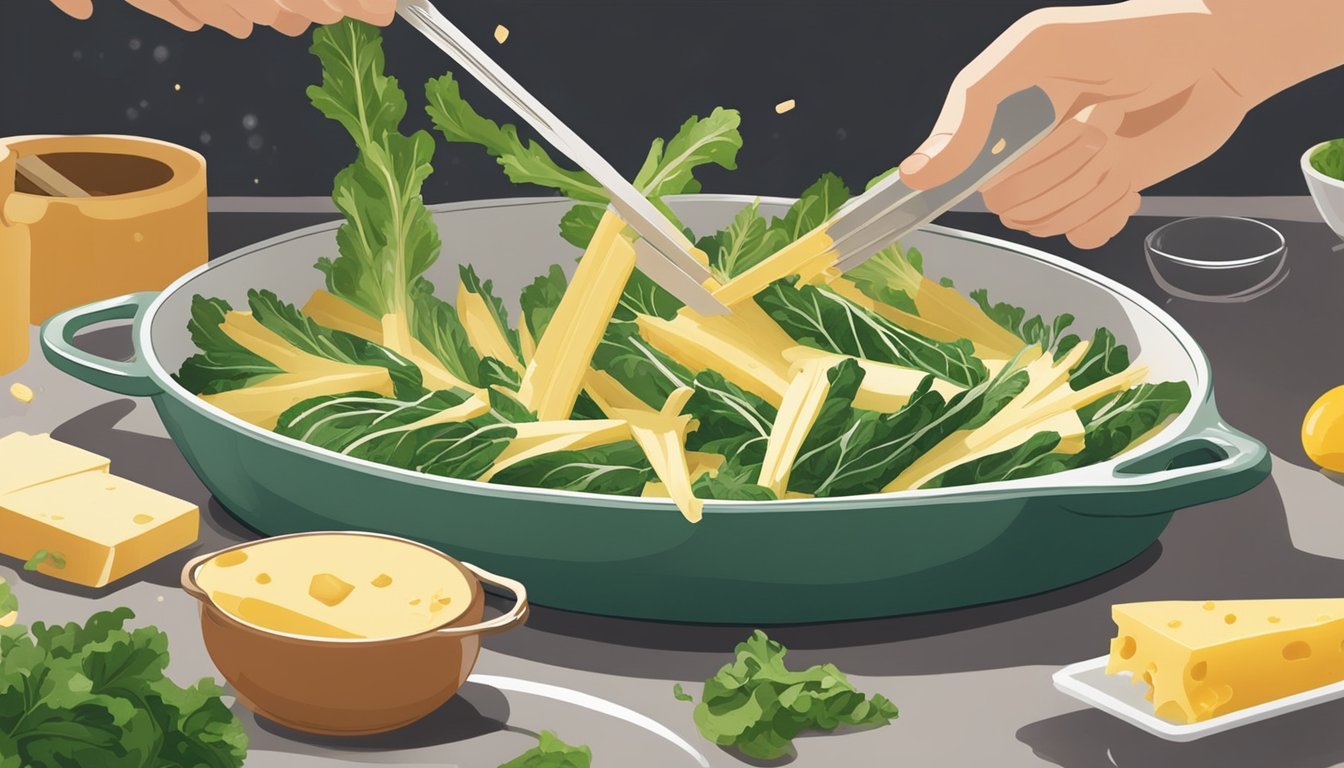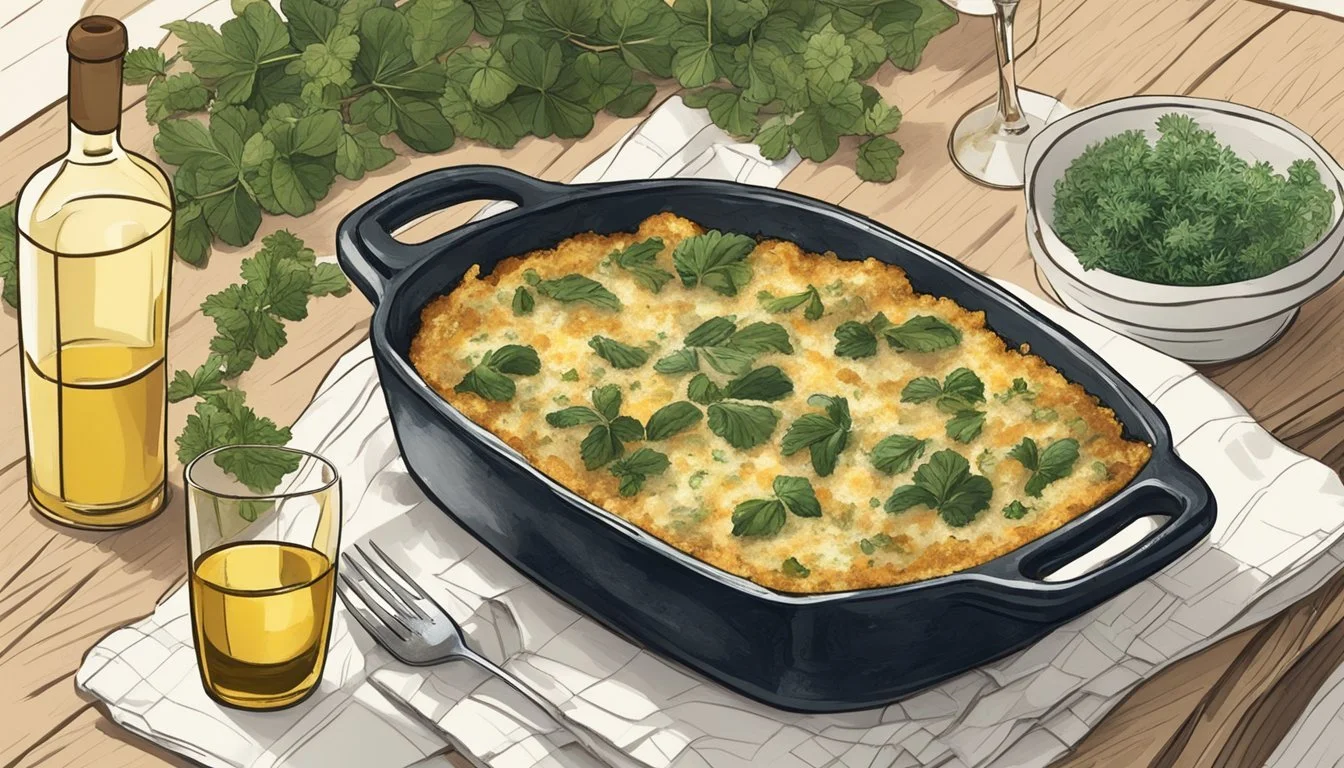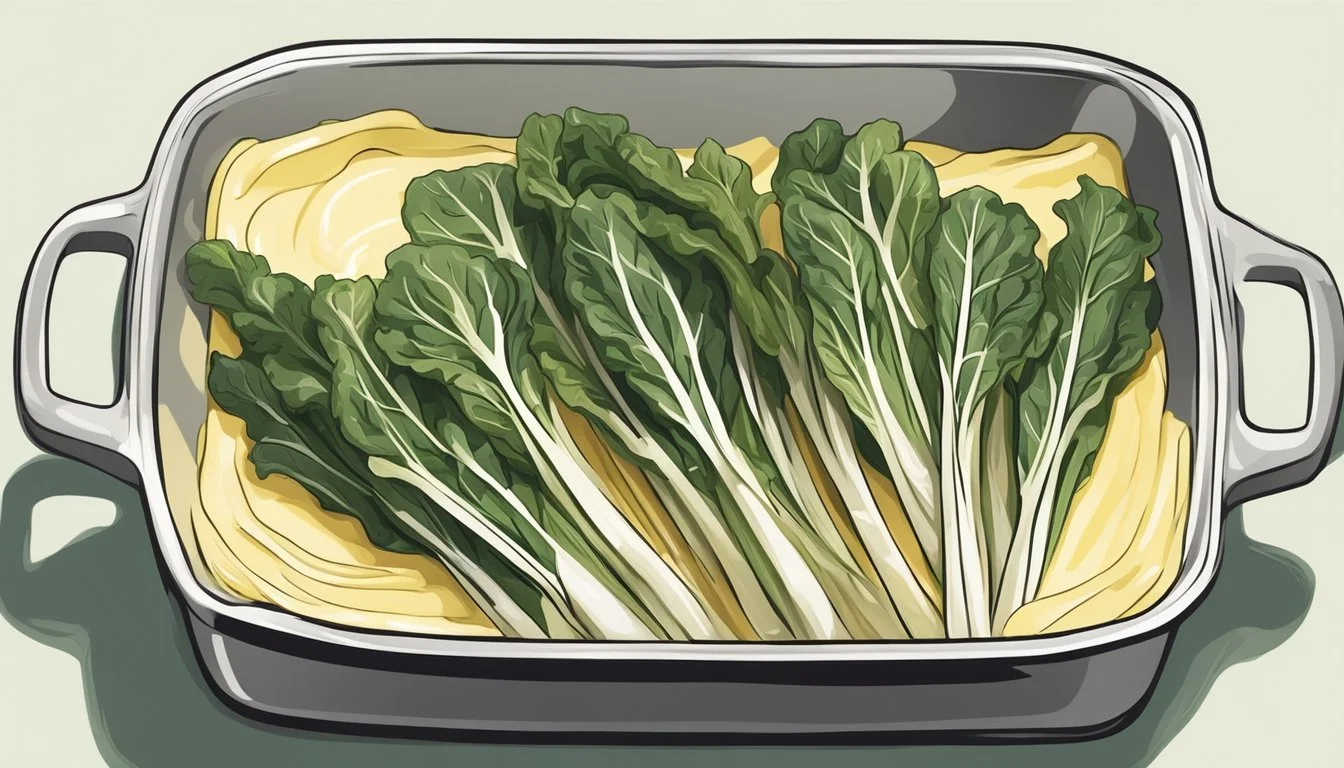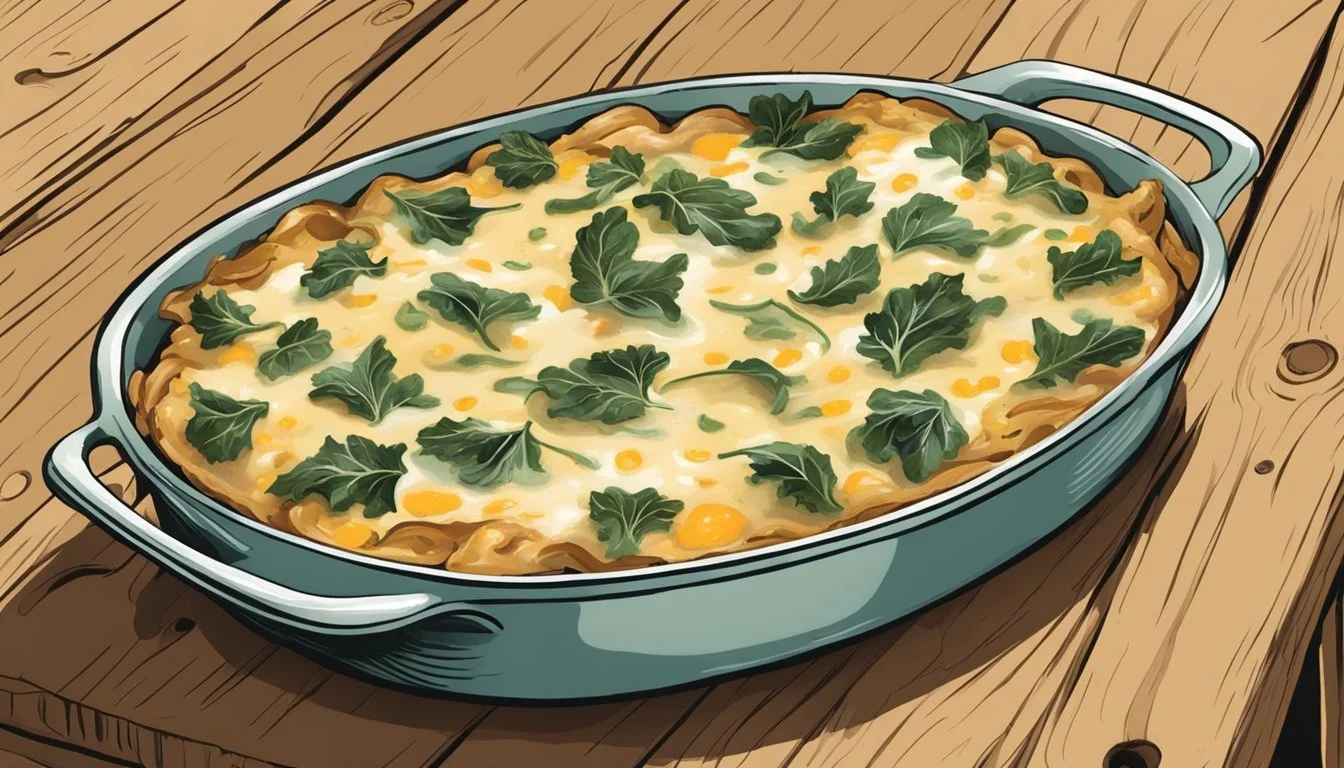Chard Stem Gratin
The Ultimate Cheesy Casserole Delight
Chard stem gratin emerges as a celebration of resourcefulness and comforting flavors, transforming the often-overlooked stems of Swiss chard into the star of a hearty casserole (What wine goes well with casseroles?). Rich in nutrients and providing a satisfying crunch, chard stems are enlivened with a blend of cheeses and a creamy sauce in this dish, making it a perfect example of how home cooks can elevate simple ingredients into an elegant side or main dish. Encased in a golden, cheesy crust, this casserole is a testament to the versatility of garden greens and a reflection of a growing culinary trend towards whole-vegetable cooking.
As the palate leans towards more sustainable eating practices, chard stem gratin offers an inventive use for the whole chard plant, minimizing waste and maximizing flavor. The gratin involves a straightforward process of preparing the chard, crafting a rich béchamel-based sauce laden with cheese, and then baking the mixture to achieve a bubbly, golden crust. Not only does it make for a comforting meal on its own, but it also serves as a delightful companion to a variety of main courses, fitting seamlessly into both casual family dinners and more formal dining occasions.
Whether served as a centerpiece in a vegetarian feast or as an innovative side, chard stem gratin captures the essence of comfort food with a gourmet twist. Its preparation is accessible to cooks of all skill levels, further cementing its place in the repertoire of those seeking to make the most of their garden's bounty while offering something uniquely satisfying to their table.
Understanding Chard
Chard, often known as Swiss chard, is a leafy green vegetable that is praised for its nutritional value and its vibrant stems in various colors. The two focal points of this section delve into the different varieties of Swiss chard and the health benefits associated with its consumption.
Swiss Chard Varieties
Swiss Chard comes in a range of types, each distinguishable by the color of their stems and slight differences in flavor. Prominent among them are:
Fordhook Giant: Identifiable by its wide, white stems and deep green leaves, known for its robust flavor.
Ruby Red (Rhubarb Chard): Sports bright red stems with dark green leaves edged in red, and has a slightly earthier taste.
Rainbow Chard: A colorful mix of chards, with stems that can be yellow, red, purple, or white, making it a popular choice for both taste and visual appeal in dishes.
Health Benefits of Chard
Chard is more than just a colorful addition to meals; it is a powerhouse of nutrients. Its benefits include:
Vitamins and Minerals: Chard leaves are rich in vitamins A, C, E, K, and essential minerals like magnesium, manganese, and iron.
Antioxidant Properties: The dark green leaves of chard are laden with antioxidants, which combat free radicals in the body.
By incorporating chard into dishes like gratins, individuals not only enhance flavor but also consume a vegetable that supports overall health and well-being.
Preparation of Chard Stems
When it comes to preparing chard stems for a gratin, cleanliness and precision in cutting are pivotal for achieving the right texture and flavor. The process includes thorough washing and accurate sizing of the stems in addition to a crucial blanching step to ensure they achieve a tender bite.
Cleaning and Cutting
Chard stems should be separated from the leafy greens, as they require distinct handling. Begin by rinsing the stems under cold water to remove any dirt or debris. A gentle scrub can be used for stubborn soil. Once cleaned, one should cut the stems into uniform pieces, approximately 2.5cm in length, to promote even cooking.
Blanching the Stems
Blanching is a technique that softens the stems while preserving their vibrant color and nutrients. To blanch chard stems:
Fill a pot with water and bring to a rolling boil.
Add a generous pinch of salt to the boiling water.
Place the chard stems into the water and allow them to boil until they start to become tender—about 10 minutes.
Immediately remove the stems from the boiling water and plunge them into an ice water bath to halt the cooking process.
This method ensures that the chard stems are sufficiently tender to be layered into the gratin without losing their structural integrity when baked in the casserole.
Crafting the Gratin Base
Chard stem gratin combines the mild, earthy flavor of chard with a rich and creamy cheese sauce. A successful gratin relies on the selection of suitable cheese and the creation of a smooth béchamel sauce.
Choosing the Right Cheese
The choice of cheese is crucial for flavor and texture. Gruyère cheese is favored for its excellent melting qualities and slightly sweet nuttiness. Parmesan is another popular choice, adding a sharper, more savory note to the dish. A blend of the two can create a well-rounded flavor profile. It's essential to grate the cheese finely to ensure even melting within the gratin.
Recommended cheeses:
Gruyère: melts well, nutty flavor.
Parmesan: adds depth, savory note.
Creating the Béchamel Sauce
Béchamel serves as the creamy base for the gratin. Start by melting butter in a saucepan, then whisk in an equal amount of flour to form a roux. Gradually add milk while continuously stirring to prevent lumps. Season the sauce with a pinch of nutmeg, salt, and ground black pepper for warmth and depth. Some recipes may include mustard for additional complexity. The béchamel is ready when it is thick enough to coat the back of a spoon.
Steps for béchamel:
Melt butter over medium heat.
Whisk in flour to create a roux.
Slowly incorporate milk, stirring constantly.
Season with nutmeg, salt, and black pepper.
Add mustard to taste (optional).
Cook until sauce is thick and smooth.
Assembling the Casserole
Assembling the Swiss chard gratin casserole involves a thoughtful layering of ingredients to create a harmonious blend of textures and flavors, finished with a crunchy breadcrumb topping that adds a satisfying contrast to the creamy base.
Layering Ingredients
To begin the assembly of the casserole, one should start by preheating the oven to 350 degrees Fahrenheit. As this is a cheesy casserole, one of the essential layers is a mixture of cheeses that could include varieties like Gruyère or cheddar, for their melting qualities and flavor profiles. They should bring creaminess and a savory depth to the gratin.
First, lightly grease the casserole dish with extra virgin olive oil or butter, ensuring that cleanup will be easier and the gratin does not stick.
In a large bowl, combine the cooked chard stems and leaves, which have been prepared by separating them, chopping the stems, and cooking both until tender. The chard should be well-drained to prevent a watery casserole.
Mix in sautéed shallots, onions, or garlic, cooked until they are translucent but not browned, infusing the dish with a fragrant base flavor.
Season the chard mixture with thyme, sea salt, and a hint of lemon zest to elevate the greens with aromatic and bright notes.
Spread a layer of this savory chard mixture into the baking dish.
Pour a mixture of cream, and additional cheese over the chard, ensuring that it is evenly distributed for a uniformly creamy texture.
Adding Crunch with Breadcrumbs
The final touch for the Swiss chard gratin is a crunchy topping that offers a contrast to the creamy layers beneath.
In a small pan, one can melt butter or heat a splash of extra virgin olive oil before adding breadcrumbs or panko. For those seeking a gluten-free option, gluten-free breadcrumbs will serve wonderfully.
Stir the breadcrumbs in the pan until they are golden and coated with the fat, which will help them crisp up in the oven.
Sprinkle the toasted breadcrumbs evenly over the top of the casserole. The even spread will ensure a consistent crunch in every bite.
Place the assembled casserole into the preheated oven, allowing it to bake until the topping is a deeper golden brown and the casserole is bubbling around the edges, typically about 30 minutes.
The casserole is now ready to be baked until golden perfection is achieved.
Customizing Your Gratin
When preparing a chard stem gratin, one can easily tailor the dish to suit personal preferences or dietary needs. Substitutions and omissions are possible without compromising the essential character of this comforting casserole.
Alternative Ingredients
For those looking to explore beyond the classic recipe, a great many variations beckon. Potatoes, thinly sliced, can serve as a hearty base, transforming the dish into a potato-chard hybrid gratin. Instead of using common cheeses like gruyere or swiss cheese, one can opt for parmesan cheese to add a saltier, more umami-rich flavor profile.
In terms of the cream element, while traditional recipes may call for heavy cream or whole milk, these can be substituted with low-fat milk to reduce the dish's overall richness and calorie count. A roux made with gluten-free flour can be used to thicken the gratin for those requiring a gluten-free option.
Adjusting for Dietary Restrictions
Adapting the chard stem gratin to meet dietary restrictions does not have to be a daunting task. For a lower fat version, select low-fat milk over heavy cream or whole milk, and reduce the cheese content or choose a reduced-fat cheese alternative.
Individuals who are gluten-intolerant can replace traditional flour used for thickening the gratin with a gluten-free alternative, ensuring the gratin remains a safe choice. For those who do not consume eggs, binding the ingredients can also be achieved using a small amount of gluten-free breadcrumbs or a sprinkle of extra cheese to form a crisp topping.
Baking to Perfection
The proper baking process is critical for a Chard Stem Gratin to achieve its signature cheesy texture and golden crust. This section provides guidance on the correct temperature settings and timing, as well as techniques to attain a golden brown top layer that is both visually appealing and delicious in taste.
Temperature and Timing
One should preheat the oven to the ideal temperature of 350-375°F (175-190°C) before inserting the gratin dish. Consistent heat is vital for the gratin to cook evenly. Baking time generally ranges from 25 to 35 minutes, but it is essential to monitor the dish as ovens may vary in performance. The gratin should be placed in the center of the oven to ensure even heat distribution.
Key Action Temperature (°F) Timing Preheat Oven 350-375 Before inserting Bake Maintain same 25-35 minutes Check for Doneness - Around 25 minutes
Achieving Golden Brown Excellence
For an exquisite golden brown surface, one may increase the temperature or utilize the broiler during the last few minutes of baking. This action allows the top cheese layer to caramelize without overcooking the interior. Breadcrumbs, if used in the recipe, will also contribute to the golden color and provide a satisfying crunch. One must keep a close eye on the gratin at this stage, as the transition from perfectly golden to burnt can occur quickly.
Use Broiler: Only for a few minutes at the end
Monitor Closely: To prevent burning
Breadcrumbs: Added before the broiling step for extra crunch
The pursuit of a golden brown topping is not just for aesthetics; it's also a sign of a well-cooked gratin with a delightful contrast of textures.
Serving Suggestions and Pairings
When it comes to savoring Chard Stem Gratin, the right accompaniments can elevate this already delectable casserole. Pairings should complement the robust, cheesy flavor, and servings should be generous to satisfy comfort food cravings.
Complementing Flavors
Chard Stem Gratin, with its rich, cheesy goodness, pairs wonderfully with a variety of flavors that cut through the richness. A crisp, acidic white wine such as Sauvignon Blanc or a light Pinot Grigio brings out the best in the gratin. For non-alcoholic options, a sparkling water with a squeeze of lemon or lime complements the dish's creaminess.
When thinking of side dishes, consider:
Simple salads: A green salad with a vinaigrette dressing adds freshness and vibrancy.
Roasted vegetables: Carrots or asparagus roasted with olive oil and sea salt provide a sweet and earthy contrast.
Crusty bread: A slice of freshly baked sourdough or a baguette offers a satisfying textural contrast, perfect for mopping up any leftover creamy sauce.
Plating and Presentation
A Chard Stem Gratin should be served hot, straight from the oven, to ensure that each serving captures the oozy, melted cheese on top.
Consider the following:
Individual ramekins: For a personal touch, bake the gratin in individual portions.
Casseroles: If using a larger casserole dish, use a sharp knife and a sturdy spatula to serve neatly squared portions.
Color contrast: Garnish with a sprinkle of bright herbs like parsley or chives to add a pop of color.
Remember, leftovers can be kept covered in the refrigerator and reheated, making sure the gratin remains a comforting meal even the next day.
Storing and Reheating
Proper storage maintains the chard gratin's texture and flavor, while correct reheating ensures that it tastes as good as when first baked. Here are tips to keep leftovers fresh and how to reheat them properly.
Refrigeration Tips
Chard gratin should be cooled to room temperature before storing to prevent condensation, which can make the casserole soggy. Once cooled, the casserole should be:
Covered tightly with either cling film or aluminum foil to keep out air and moisture.
Refrigerated within two hours of cooking to prevent bacterial growth.
Ideally stored in an airtight container if it will be kept for more than a couple of days.
Best Reheating Practices
When reheating leftover chard gratin, one should aim to preserve its creamy texture and prevent the cheese from separating. Here are the best methods:
Oven: Preheat to 350°F and cover the casserole with foil. Heat until warm throughout, usually about 20 minutes.
Microwave: Use a microwave-safe dish and cover loosely. Reheat on medium power in short intervals, stirring when possible, to distribute heat evenly.
Frequently Asked Questions
What is Chard Stem Gratin?
Chard Stem Gratin is a casserole dish that primarily utilizes the stems of Swiss chard. The stems are baked in a creamy cheese sauce, often topped with breadcrumbs for added texture.
Can you use only the stems of the Swiss chard?
Yes, one can use the stems only. Swiss chard stems are tender when cooked and pair well with creamy sauces (What wine goes well with creamy sauces?) and cheese.
What kind of cheese works best for this dish?
A variety of cheeses can be used; common options include Gruyère, Parmesan, or sharp Cheddar. These cheeses melt well and contribute to the gratin’s rich flavor.
How long does it take to prepare and cook?
Preparation takes about 15 minutes, and cook time is approximately 30 minutes. However, times may vary depending on the recipe specifics and oven variations.
Is it necessary to pre-cook the chard stems?
It is advisable to parboil the stems first to ensure they are tender. Typically, this takes a few minutes in boiling water.
Can this dish be made in advance?
This casserole can be assembled ahead of time and refrigerated. Before serving, bake it until it's hot and bubbly.
Is Chard Stem Gratin gluten-free?
Not typically, due to breadcrumbs. For a gluten-free version, one may use gluten-free breadcrumbs or omit them entirely.
Can other vegetables be added to the gratin?
Yes, other vegetables like potatoes or leeks can be added. Ensure they are pre-cooked as needed to match the texture of the chard stems.
Conclusion
Chard stem gratin stands out as a nourishing and flavorful comfort food. It is versatile enough to serve as a main dish for vegetarians or a hearty side for meat-lovers. This casserole takes advantage of the entire chard plant, with its leafy greens and sturdy stems, resulting in minimal waste and maximum nutrients.
The dish’s richness comes from the melting cheese and creamy béchamel that blanket the chard stems. With the right balance of seasoning, including salt, pepper, and a touch of nutmeg, the flavors are perfectly accentuated. Breadcrumbs provide a satisfying crunch that complements the tender texture of the baked stems and greens.
For those looking to tailor this gratin to specific dietary needs, substitutions are possible:
Low-fat cheese for a lighter option
Gluten-free breadcrumbs for a gluten-intolerant audience
Dairy-free alternatives for a vegan-friendly variant
A well-prepared chard stem gratin showcases the best of what seasonal produce has to offer. It is a testament to the creativity and resourcefulness that can be brought to everyday ingredients. With each layer delicately constructed, diners are treated to a symphony of textures and flavors, while also benefiting from the leafy greens’ abundance of vitamins and minerals.
Whether it graces a weeknight dinner table or the spread of a special feast, chard stem gratin remains a dignified testament to the beauty of using whole vegetables in home cooking.










